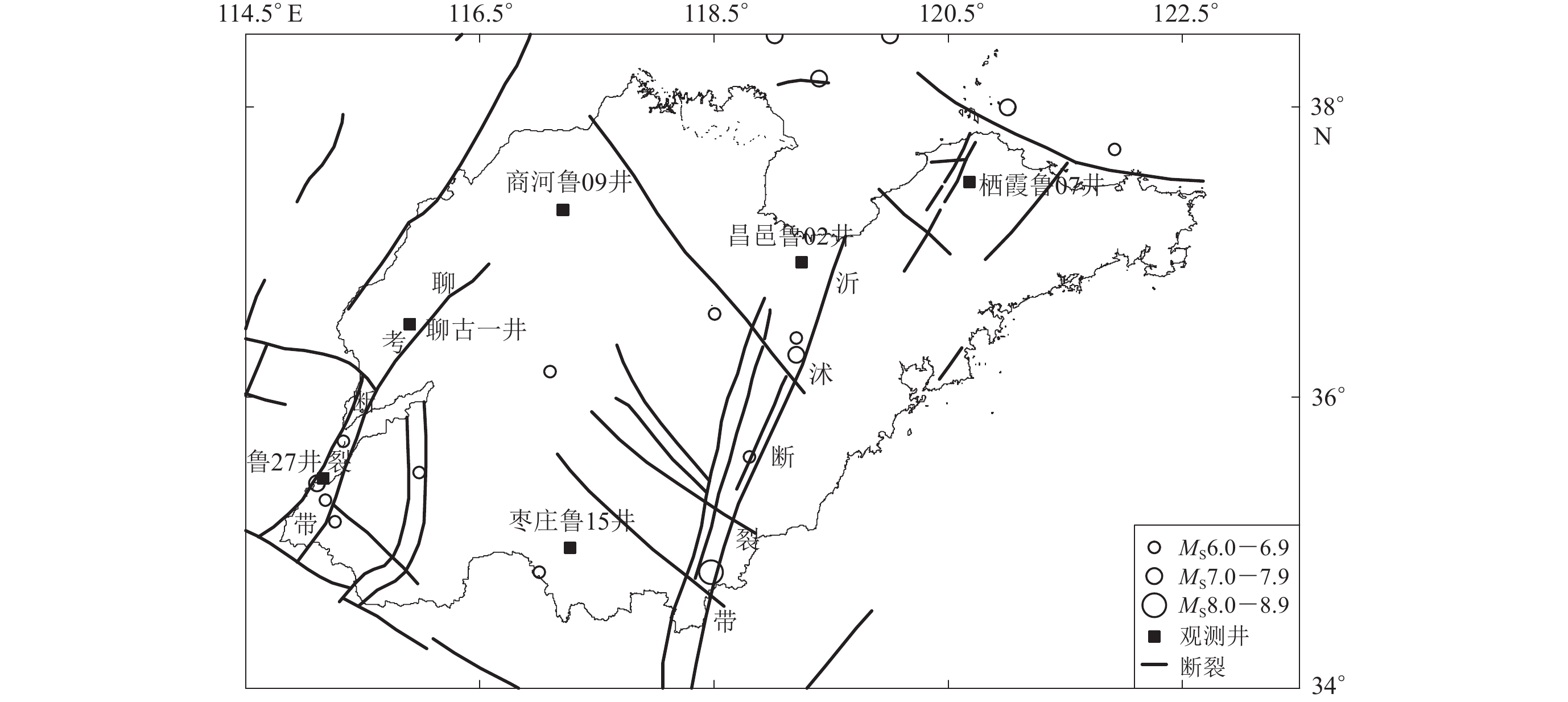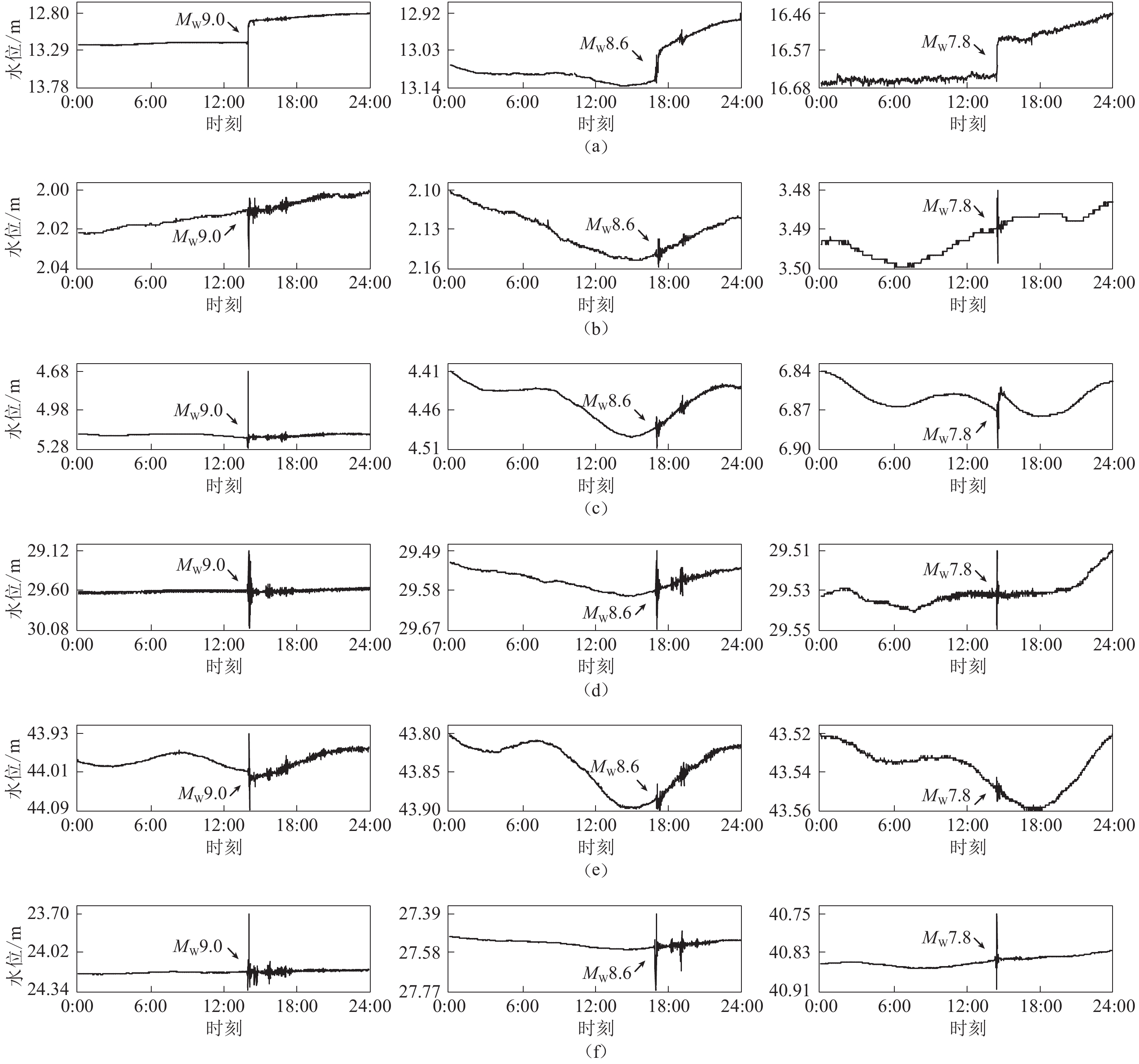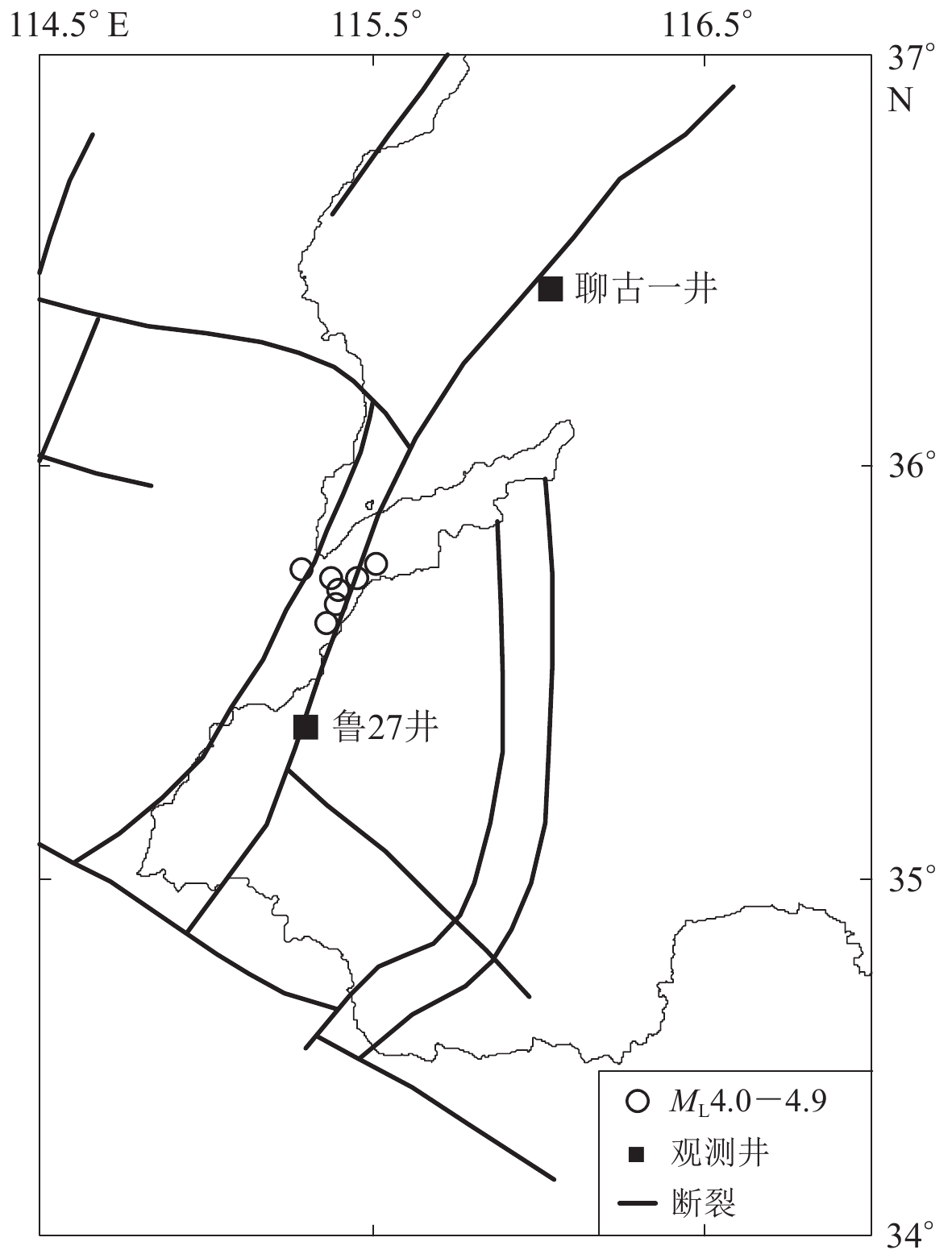Comparative analysis on coseismic response of water level in Shandong Province to several major earthquakes
-
摘要: 采用多井对多震的方式,选取山东省地下流体观测井网中同震响应较好的6口观测井作为研究对象,分别从水位变化形态和幅度对比分析2011年日本MW9.0地震、2012年苏门答腊MW8.6地震和2015年尼泊尔MW7.8地震引起的井水位变化特征,探讨引起该变化的可能机理。研究结果显示:水位同震变化形态以振荡为主;通过定量分析认为聊古一井井水位的阶升是由含水层渗透系数增大所致;位于同一断裂带上的聊古一井和鲁27井井水位在同一地震中所表现的变化形态不同,可能与两个观测井所处的地质构造条件和地震活动背景不同有关;区域应力场的变化会影响栖霞鲁07井的水位同震变化形态;水位同震变化幅度与震级、井震距存在一定关系,同时也取决于含水层水文地质条件的变化量。Abstract: In the form of multi-well to multi-earthquake, six wells with good coseismic responses in the underground fluid observation network of Shandong Province are selected to analyze the coseismic variations of water level caused by the Japan MW9.0 earthquake, the Sumatra MW8.6 earthquake and the Nepal MW7.8 earthquake. We analyze the characteristics in the aspects of type and amplitude, and discuss the response mechanism. The results show that the major type of coseismic variations is oscillation. With quantitative analysis, we find that the rise of Liaogu-1 water level is due to the increase of permeability coefficient of aquifer. The different types between Liaogu-1 well and Lu-27 well on the same fault zone are due to the different regional geological conditions and seismic activities. The water level coseismic variation type of Lu-07 well is affected by local tectonic stress. The amplitude of water level coseismic variation is related to the magnitude and the distance between well and epicenter, and also depends on the change of hydrogeological condition.
-
Keywords:
- water level /
- earthquake /
- coseismic response /
- aquifer /
- Shandong Province
-
引言
青藏高原地质构造复杂,地质、大地测量及地震构造等研究普遍表明,青藏高原内地壳变形分布广泛:高原内中部地壳主要沿着汇聚方向东西缩短,南部地壳向东西方向伸展,中北部及东部地壳向东部挤出,与云南和缅甸接壤的东南缘地壳向东南或正南方向挤出并在喜马拉雅东构造结处发生顺时针旋转(Molnar,Tapponnier,1975;Holt et al,1991;Wang et al,2001;Zhang et al,2004)。青藏高原内分布有大量断裂带,构造活动丰富,地震频发(Yin,Harrison,2000;邓起东等,2014;叶卓等,2018)。地震层析成像和大地电磁探测等成果均显示青藏高原中下地壳存在低速区(Yang et al,2012;Jiang et al,2014;Bao et al,2015)和高电导率区(金胜等,2010;Bai et al,2010),这表明中下地壳可能处于部分熔融状态(Chung et al,2003;Le Pape et al,2012;Long et al,2015)。作为青藏高原主体的中东部地区,从北到南依次分布着柴达木地块、巴颜喀拉地块、羌塘地块和拉萨地块,是研究青藏高原形成与演化的重要区域,也是研究高原中下地壳低速区成因和分布特征的重要区域。研究该区域地壳和上地幔顶部的速度结构和物性特征,可以推断青藏高原的物质迁移和地壳形变机制,对于理解大陆碰撞机制和生长过程具有重要作用,因此研究青藏高原中东部地壳和上地幔顶部的速度结构特征具有十分重要的意义。此外,青藏高原中东部的地震观测数据丰富,地震事件分布相对均匀,为层析成像提供了有利条件。
近年来,除了利用GPS (Chen et al,2000;Allmendinger et al,2007;Hao et al,2016)和InSAR (李鹏等,2013;Garthwaite et al,2013;Zhao et al,2016)等方法对青藏高原中东部进行地表观测研究之外,研究人员对青藏高原乃至整个中国大陆进行了大量的地震波层析成像工作,例如,Pn波层析成像(Liang,Song,2006;黎源,雷建设,2012)、S波层析成像(Mechie et al,2012;黄忠贤等,2013)、远震或近震P波层析成像(Zhang et al,2012;Lei,Zhao,2016)、背景噪声及地震面波层析成像(Yao et al,2006;Ceylan et al,2012;范文渊等,2015;Pandey et al,2015;钟世军等,2017)和全波形层析成像(Chen et al,2015,2017),取得了很多有意义的研究成果,其中近震P波走时成像仍是地震层析成像的重要手段。传统的近震P波层析成像方法主要是采用地壳P波和上地幔顶部Pn波分别反演的策略,这样可以避免莫霍面对地壳速度结构的影响,但是却容易造成部分高质量数据的浪费。尤其在Pn波层析成像中,忽略地壳横向非均匀性的影响可能会对构造复杂地区(青藏高原等)的反演结果带来较大误差(Li et al,2017),而使用Pn和Pg震相走时联合反演的方法能减小这种误差,取得较好的成像结果(Xu,Song,2010;Huang et al,2013)。为此,本文提取研究区域内1991—2017年地震事件的初至波走时信息,拟利用Pg和Pn波震相走时联合反演方法,对青藏高原中东部的三维P波速度结构进行层析成像,以期得到该地区的地壳P波速度结构、上地幔顶部Pn波速度结构及地壳厚度信息。
1. 数据和方法
1.1 数据选取
我们从美国地震联合会(Incorporated Research Institutions for Seismology,简称IRIS)数据中心收集了青藏高原中东部(88°E—100°E,25°N—40°N)从1991年到2017年共6 617个地震事件的波形记录。为保证数据质量,进行数据筛选,标准如下:① 震级ML≥2.5;② 震源深度d<60 km;③ 震中距≤12°。图 1给出本文所使用的地震台站分布及相应的台网代码和观测周期。
采用Sacpick自动拾取方法,基于地震波形数据对初至波走时进行拾取,具体流程如下:① 根据预设模型计算生成初至波理论走时t;② 根据理论走时选取一定的噪声窗口和信号窗口,本文选取噪声窗口为[t-40 s,t-10 s],信号窗口为[t-20 s,t+10 s];③ 通过滑动窗口寻找振幅发生变化的信号并计算信号窗口与噪声窗口的均方根(root mean square,缩写为RMS)比值,当两者之比大于某一预设值(本文预设值取为5)时,认为该信号有效并予以采用。
本文通过对245个台站记录的1 776个地震事件的地震波形进行自动拾取,最终得到1万4 484个初至波到时数据。图 2给出了2008年12月18日某地震事件初至波自动拾取的示例,可以看出,采用自动拾取走时方法能够将信噪比差的数据直接剔除,保留高质量的数据,并且有效地减少走时拾取中的人为因素,使拾取的走时具有较好的一致性。由于拾取到的到时数据为初至波走时,并非具体的Pg或Pn震相走时,因此在层析成像的每次迭代反演中,还需要分别计算Pg波和Pn波理论走时,并将其与观测走时进行对比,实现初至波震相的判别。
1.2 方法步骤
采用Xu和Song (2010)提出的联合Pg和Pn震相走时反演方法,对Pg波和Pn波走时采用不同的计算方法。在球面坐标系下,利用伪弯曲射线追踪方法(Koketsu,Sekine,1998),Pg波从震源j到台站k的走时残差为
${r_{jk}} = t_{jk}^{{\rm{obs}}} - t_{jk}^{{\rm{pred}}} = \sum\limits_{i = 1}^n {\left({ - \frac{{{\rm{d}}l}}{v}} \right){{\left({\frac{{\Delta v}}{v}} \right)}_i}}{\text{,}}$


(1) This page contains the following errors:
error on line 1 at column 1: Start tag expected, '<' not foundBelow is a rendering of the page up to the first error.
Pn波从震源j到台站k的走时残差为
${r_{jk}} {\text{=}} t_{jk}^{{\rm{obs}}} {\text{-}} t_{jk}^{{\rm{pred}}} {\text{=}} \sum\limits_{{{m}} {\text{=}} 1}^{{n_1}} {\left({ {\text{-}} \frac{{{\rm{d}}l}}{v}} \right){{\left({\frac{{\Delta v}}{v}} \right)}_{{m}}} {\text{+}} } \sum\limits_{{{e}} {\text{=}} 1}^{{n_2}} {\left({ {\text{-}} \frac{{{\rm{d}}l}}{v}} \right){{\left({\frac{{\Delta v}}{v}} \right)}_{{e}}} {\text{+}} \sum\limits_{{{r}} {\text{=}} 1}^{{n_3}} {\left({ {\text{-}} \frac{{{\rm{d}}l}}{v}} \right){{\left({\frac{{\Delta v}}{v}} \right)}_{{r}}} {\text{+}} } \eta \Delta {h_k} {\text{+}} \Delta {t_j}}{\text{,}} $


(2) 式中,等号右边第一项为射线沿莫霍面滑行的走时,第二项为震源端地壳部分走时,第三项为台站端地壳部分走时,第四项η∆hk为台站端莫霍面深度变化引起的走时变化,其中
$\eta = \sqrt {{{\left({\dfrac{1}{{{v_{\rm{c}}}}}} \right)}^2} - {{\left({\dfrac{1}{{{v_{\rm{m}}}}}} \right)}^2}}$


(3) 为垂直慢度,vc和vm分别为该处地壳Pg波速度和Pn波速度,第五项Δtj为震源延迟项。
This page contains the following errors:
error on line 1 at column 1: Start tag expected, '<' not foundBelow is a rendering of the page up to the first error.
2. 计算结果
2.1 一维模型和参数化
由于本文研究区域与Xu和Song (2010)一文研究区域的地理位置比较靠近且东部有部分重叠,为减少反演迭代次数,在计算一维模型时参考其一维P波速度模型,将该模型作为初始地壳速度模型。通过走时数据拟合,得到Pn波平均速度约为8.08 km/s,地壳平均厚度约为55 km。将一维速度模型中地壳的最后一层延伸至55 km深度,得到初始一维速度模型,地壳模型均匀分层,每层厚度为10 km,最后一层划分至55 km (即莫霍面深度处)。采用Pg波和Pn波震相走时联合反演方法确定最终一维速度模型,经过7次迭代反演后残差不再明显降低,此模型即为后续层析成像所使用的一维速度模型(图3)。
采用计算得到的一维速度模型,利用所有初至波走时数据进行三维联合反演。反演采用的地壳速度水平网格、Pn波速度水平网格和莫霍面深度网格的大小均为0.5°×0.5°。联合反演中,震相判别时Pg波和Pn波两者理论走时与观测走时之差的绝对值均小于1 s的数据将不予采用,以减少由于模型粗糙所造成的震相误判,且在计算中要求参与反演的射线走时残差不大于3 s,以防止少量数据对模型造成过大影响。每次迭代结束后,更新模型进行下一次迭代反演。
2.2 残差和分辨率
本次联合反演的初始数据共1万4 484个初至波走时,最终参与反演的射线有1万零444条,射线基本覆盖了研究区域(图4)。
经过8次迭代后,残差不再明显降低,得到联合反演的最终结果,反演后走时残差的分布有一定改善(图5a),但并不十分显著,说明本文采用的初始模型与本区域的真实速度结构比较接近,即Xu和Song (2010)的地壳模型对于本文研究具有较好的参考意义。除震中距大于10°的区间射线数量不足外,反演后各震中距区间的走时残差标准差(图5b)均在一定程度上有所降低,反演后走时残差分布更集中(图5c),走时残差的RMS由初始模型的1.50 s降低至1.21 s,同时参与反演的射线折合走时分布较为均匀(图5d),模型拟合得较好。
![]() 图 5 联合反演的残差分析和走时分布(a) 反演前后走时残差随震中距的分布;(b) 反演前后各震中距范围内走时残差的标准差分布;(c) 联合反演前后走时残差数量分布及其高斯分布拟合曲线;(d) 折合走时(t−d/0.065)分布Figure 5. Residual analysis and travel time distribution of joint inversion(a) Travel time residual distribution before and after inversion;(b) Standard deviations of travel time residuals with different epicentral distance before and after inversion;(c) Histogram of residuals and its Gaussian distribution fitting before and after inversion;(d) Reduced time by 0.065 degree per second
图 5 联合反演的残差分析和走时分布(a) 反演前后走时残差随震中距的分布;(b) 反演前后各震中距范围内走时残差的标准差分布;(c) 联合反演前后走时残差数量分布及其高斯分布拟合曲线;(d) 折合走时(t−d/0.065)分布Figure 5. Residual analysis and travel time distribution of joint inversion(a) Travel time residual distribution before and after inversion;(b) Standard deviations of travel time residuals with different epicentral distance before and after inversion;(c) Histogram of residuals and its Gaussian distribution fitting before and after inversion;(d) Reduced time by 0.065 degree per second由于DLSQR方法求得的结果无法得到方程解的误差矩阵,因此采用检测板测试(Lévěque et al,1993)对反演结果的可靠性进行分析。本文采用与实际数据反演相同的参数设置,对速度模型添加±4%的扰动,并通过反演进行恢复成像。通过多次试验,在网格大小为1.5°×1.5°时速度恢复情况较好,而边缘部分地区由于射线覆盖不足,无法得到理想的恢复效果(图6)。
2.3 反演结果
本文获得了青藏高原中东部地区地壳和上地幔顶部的P波三维速度结构及莫霍面深度信息(图7)。反演结果显示:地壳P波速度处于5.2—7.2 km/s之间,地壳同一深度处,P波速度变化范围较大,表明研究区域存在强烈的横向不均匀性;不同深度P波高、低速分布情况存在很大差异,20 km深度以上地壳部分与30 km深度以下地壳部分的P波高、低速分布也呈现出明显的纵向非均匀性;从地壳30 km深度处开始存在大片明显的低速区并一直延伸至莫霍界面;上地幔顶部Pn波速度存在较大的横向不均匀性,速度值主要分布在7.7—8.4 km/s之间,研究区域内Pn波速度在南部的拉萨地块和北部的柴达木盆地主要表现为高速异常,中间的羌塘地块西部和巴颜喀拉地块部分主要表现为低速异常,具有较大的横向差异;莫霍面深度约在48.0—68.6 km,主要表现为南深北浅(图8)。
由于研究仅聚焦于青藏高原中东部,本次反演结果显示的P波速度结构与Huang等(2014)得出的三维P波速度结构整体上具有一致性,但结果更精细、速度扰动程度更大,这种差异可能来自于数据和区域特征所确定的反演参数。如图7所示,上地壳(0—20 km)与中下地壳(30—50 km) 的高、低速分布存在明显差异,说明青藏高原中东部地区的上、下地壳结构存在显著不一致性。地壳0—20 km深度内高速异常主要分布在中部的巴颜喀拉地块和羌塘地块,低速异常主要分布在南北两端的拉萨地块和柴达木地块;当地壳深度大于30 km时,低速异常主要分布于羌塘地块、拉萨地块东部,而高速异常主要分布于柴达木地块和拉萨地块西部及其以南部分。柴达木地块在上地壳主要表现为低速异常,速度值低于5.5 km/s,30 km以下深度则主要表现为高速异常,速度值高于7.0 km/s。羌塘地块和巴颜喀拉地块西部在地壳0—20 km深度表现为高速异常,30 km以下则表现为低速异常。此外,巴颜喀拉东部在不同深度处均表现为高速异常,拉萨地块西部出现明显高速异常,东部则主要表现为低速异常。
Pn波速度分布(图7)存在显著的空间差异,此结果与前人的成像结果(Liang et al,2004;王海洋等,2013;Li,Song,2018)基本一致,但细节更加明显,显示出青藏高原中东部Pn波速度强烈的横向不均匀性。柴达木地块和拉萨地块上地幔顶部总体上表现为较高的Pn波速度,最高可达8.3 km/s。巴颜喀拉地块、羌塘地块总体上表现为低速,最低约为7.7 km/s。Liang和Song (2006)的研究结果是青藏高原Pn波层析成像的重要工作,本次成像得到的Pn波速度区间较Liang和Song (2006)对青藏高原成像的结果更大,高、低速异常更明显,但总体上来说速度异常的变化趋势与其一致,主要表现为羌塘地块西部和巴颜喀拉地块Pn波速度显示为低速异常,柴达木盆地和拉萨地块的Pn波速度主要显示为高速异常。
由于台站空间分布的限制,本文反演得到的地壳厚度信息具有一定的局限性,但仍能反映出青藏高原中东部的地壳厚度变化。本文结果显示地壳厚度处于48.0—68.6 km之间(图8),莫霍面深度分布与前人研究(Shin et al,2007;高锐等,2009)也具有很好的一致性。柴达木地块和巴颜喀拉地块东缘的地壳厚度小于50 km,相对较薄,巴颜喀拉地块中部、羌塘地块、拉萨地块和青藏高原东南部的地壳厚度较大,均在55 km以上,其中青藏高原东南部地壳厚度值基本在65 km以上。
3. 讨论
3.1 地壳P波速度结构
总体说来,地壳P波速度结构显示出的结果与地质构造具有较好的对应关系。由于浅部沉积物的存在,相对于波速较快的青藏高原变质岩山体,柴达木盆地P波速度在上地壳(20 km及以上)主要表现为低速异常,在下地壳(30 km及以下)主要表现为高速异常,这一结果与Li等(2012)和范文渊等(2015)利用背景噪声得出的瑞雷波群速度表现出相似的特征,这表明盆地深部处于低温、稳定的状态。Yang等(2010,2012)对整个青藏高原中地壳进行了面波成像,其结果显示青藏高原中地壳存在大片低速区,本次研究结果显示研究区域内上、下地壳P波速度异常存在明显差异,下地壳存在大范围低速区,而结合上地幔顶部Pn波速度存在的显著低速异常,推测形成这种速度异常的原因可能是上地幔岩浆的侵入或加热作用(Godin et al,2006;Grujic,2006;Harris,2007)。Bai等(2010)利用大地电磁方法获得的结果表明,拉萨地块和羌塘地块北部中下地壳存在大片的高电导率区,本文得到的低速分布与其具有一致性,而本文结果显示的羌塘地块南部的高速异常与其得到的低电导率存在较大差异。该文指出大地电磁数据对深度电导率积分敏感,并非对特定深度的电导率值敏感,结合此区域上地幔顶部Pn波速度表现出的高速异常,推测造成这种差别的原因可能是羌塘地块南部上地幔顶部的岩性差异对该地区地壳的电导率结果产生了约束作用。
此外,Zhao等(2013)利用地震波衰减的研究结果表明青藏高原可能存在两条地壳流通道,一条从羌塘地块自北向东沿四川盆地西缘流向青藏高原东南部,另一条从青藏高原南部的拉萨地块穿过喜马拉雅东构造结,总体上本文结果显示的下地壳P波低速区与该研究对应的羌塘地块和拉萨地块东部等地壳流具有较好的对应关系,而柴达木盆地、羌塘地块西部和巴颜喀拉地块东部等高速区为地壳流非对应区域,Bao等(2011)的研究结果同样表明这些区域的Q值显著高于其它区域,重力异常的密度成像结果也显示这些区域存在明显的高密度异常(杨文采等,2015),表明这三个区域中下地壳可能存在比较稳定的地体。
3.2 Pn波速度结构
本文结果显示青藏高原南缘具有显著连续的Pn波高速异常,而羌塘地块西部和巴颜喀拉地块主要表现为Pn波低速异常,这一结果与前人研究(Zhou,Lei,2016;Lü et al,2017)具有一致性,但本文研究所得到的Pn波波速异常更为明显,也存在一些明显的细节差异。Lei等(2014)关于青藏高原东部的层析成像结果揭示了一条连通柴达木盆地与拉萨地块的南北向高速带,而根据本文结果,尽管这部分区域总体上确实表现为高速异常,但并不连续,这可能是由于我们所采用的走时数据自动拾取策略和联合不同震相的反演方法具有一定的优势,且本次研究仅对较小区域进行成像,能得到更精细的成像结果。拉萨地块以南连续的Pn波高速异常说明这部分区域的上地幔顶部岩石圈具有连续、稳定和冷的特性,可能对应了北向俯冲的印度板块,可以说明印度板块对欧亚板块的俯冲块具有较好的整体性,且其俯冲角度可能较为平缓。而在羌塘地块西部和巴颜喀拉地块呈现的Pn波低速异常,则说明这些区域上地幔顶部的温度较高,表明这些区域可能发生了岩石圈的破裂。
通常地震波的速度异常与大地热流值呈负相关关系(Black,Braile,1982;汪素云等,2003),巴颜喀拉地块、羌塘地块表现为显著低速,即该区域可能有较高的热流值,这可能与上地幔顶部的岩浆作用紧密相关,从而导致了高温异常。由于印度板块对欧亚板块的向北俯冲,拉萨地块以南显示出的高速异常可能对应了温度较低的印度板块岩石圈部分。羌塘地块西部、柴达木地块和巴颜喀拉地块东部存在的稳定区域的Pn波速度稍大于平均速度,不同于其周围的显著低速,结合地壳P波速度的高速异常,可以推断这三个稳定地体可能持续延伸至上地幔顶部。总体来说,下地壳P波速度与上地幔顶部Pn波速度结构具有耦合作用,这说明高原中部的上地幔顶部和下地壳大范围的低速与岩浆作用密不可分,可能是由于上地幔顶部岩浆的加热作用(Owens,Zandt,1997),或是在印度板块俯冲作用下岩石圈发生破裂,导致上地幔岩浆上涌至下地壳形成大范围的高温异常(Nelson et al,1996)。
3.3 地壳厚度
由于地震震源深度存在不确定性,传统的Pn波层析成像通常采用台站延迟反映地壳厚度变化。本次联合反演可以直接反演地壳厚度信息,但本质上得到的地壳厚度仍来源于台站约束。尽管存在部分数值上的差异,本文反演得到的地壳厚度变化与接收函数等方面的结果一致(Yue et al,2012;Tian et al,2014):羌塘地块东部和拉萨地块及其以南部分的地壳厚度基本大于60 km,而柴达木盆地的地壳厚度较小,主要在50 km左右。Shin等(2015)研究显示拉萨地块存在一条深达70 km的莫霍面 “条带” ,本文所得的莫霍面深度结果与其相近,造成这种地壳变厚的原因可能是由于印度板块对欧亚板块的挤压作用导致了地壳增厚,而羌塘地块的局部地壳变薄,则可能是印度板块的俯冲作用下发生的岩石圈拆沉和地幔上涌所致(Liu et al,2008;Wang et al,2014)。由于莫霍面的研究更注重大尺度的形态分布,本次研究范围较小,因此对于青藏高原整体的莫霍面分布尚需大尺度的成像研究。
4. 结论
通过对青藏高原中东部地区地壳和上地幔P波速度的联合反演,获得了较为可靠的区域三维P波模型。结果显示,青藏高原中东部地壳和上地幔顶部结构存在强烈的横向不均匀性和纵向不均匀性,显示出印度板块和欧亚板块碰撞下青藏高原地质构造的复杂特征。地壳P波速度、上地幔顶部Pn波速度、地壳厚度等均表现出显著的南北差异特征,印度板块北向俯冲导致青藏高原南部地壳增厚,羌塘地块西部部分地壳隆起。上、下地壳P波速度结构存在明显的不一致性,中、下地壳出现大范围低速,说明其物质结构和物性存在很大差异,推断为在板块俯冲作用下岩石圈发生破裂,上地幔热物质上涌到地壳导致温度上升,从而形成中、下地壳的大范围低速。羌塘、柴达木和巴颜喀拉存在三个稳定的地体且可能延续到上地幔顶部,上地幔顶部Pn波速度的强烈不均匀性和地壳厚度的剧烈变化则反映了印度板块的俯冲、挤压作用下岩石圈的物性和形态的变化特征。本文采用了程序自动拾取走时的方法提取事件初至波走时信息,同时也是联合Pg和Pn波震相走时反演方法在本区域的首次应用。本文得到的三维地壳P波速度模型对后续相关研究具有一定的参考意义,更大尺度的结构特征分析尚需进一步对整个青藏高原进行高精度成像工作。
IRIS数据中心为本研究提供了数据支持,武汉大学李孟奎博士和美国伊利诺伊大学厄巴纳-香槟分校李江涛博士对本研究提出了建议,作者在此一并表示感谢。
-
表 1 观测井基本参数
Table 1 Basic parameters of six wells
井孔名称 井深/m 所处断裂带 含水层岩性 观测仪器型号 采样率/(次·分钟−1) 聊古一井 2 337 聊考断裂带北段 灰岩 LN-3A 1 昌邑鲁02井 1 172 昌邑—大店断裂 砂岩 LN-3A 1 栖霞鲁07井 600 莱阳、栖霞、福山断裂交会处 花岗岩 LN-3A 1 商河鲁09井 2 836 济阳凹陷 灰岩 LN-3A 1 枣庄鲁15井 501 韩庄断裂北侧 砂岩 LN-3A 1 菏泽鲁27井 2 000 聊考断裂带东侧 灰岩 LN-3A 1 表 2 水位同震变化主要参数
Table 2 Main parameters of water level coseismic variations
日本MW9.0地震 苏门答腊MW8.6地震 尼泊尔MW7.8地震 井震距/km 形态 振幅/cm 井震距/km 形态 振幅/cm 井震距/km 形态 振幅/cm 聊古一井 2 353 阶升 26.5 4 471 阶升 9.3 3 072 阶升 12.1 昌邑鲁02井 2 050 振荡 3.4 4 697 振荡 1.1 3 374 振荡 1.0 栖霞鲁07井 1 914 振荡 51.7 4 828 振荡 2.9 3 508 阶升 1.1 商河鲁09井 2 220 振荡 48.7 4 612 振荡 9.3 3 200 振荡 2.4 枣庄鲁15井 2 275 振荡 7.7 4 415 振荡 1.8 3 176 振荡 0.6 菏泽鲁27井 2 445 振荡 48.1 4 337 振荡 21.3 2 990 振荡 9.6 表 3 聊古一井井水位M2波潮汐参数
Table 3 Tidal parameters of M2 wave for the water level of Liaogu-1 well
日本MW9.0地震 苏门答腊MW8.6地震 尼泊尔MW7.8地震 震前 震后 震前 震后 震前 震后 潮汐因子 2.05 2.19 2.15 2.14 2.01 2.05 相位差/° −5.20 −5.20 −6.83 −5.93 −9.67 −7.49 注:相位差为“–”代表相位滞后. 表 4 聊城—兰考断裂带各段上下盘地层厚度分布与断层特征表
Table 4 The strata thickness and fault characters of the Liaocheng-Lankao fault
层底 北段 中段 南段 上盘厚度/m 下盘厚度/m 落差/m 上盘厚度/m 下盘厚度/m 落差/m 上盘厚度/m 下盘厚度/m 落差/m 下第三系 14×103 0 14×103 4.5×103 0 4.5×103 7×103 0 7×103 上第三系 1 800 800 1 000 2 000 800 1 200 2 600 1 400 1 200 第四系 300 200 ≤100 300 200 100 ≥400 250 ≥150 上更新统 60 50 10 80 65 15 80 60 20 注:数据来源于向宏发等(2000). 表 5 响应形态固定的观测井井水位同震变化幅度
Table 5 Coseismic variation amplitude of water level for observation wells with constant response type
井点名称 井震距/km 实际变幅/cm 预测变幅/cm 聊古一井 1 389 2.2 25.79 昌邑鲁02井 1 682 0.4 1.14 商河鲁09井 1 533 0.4 0.48 枣庄鲁15井 1 443 0.3 0.19 菏泽鲁27井 1 280 1.2 3.86 -
丁风和,戴勇,宋慧英,魏建民,查斯. 2015. 大甸子井-含水层系统水文地质参数间的变化关系[J]. 地震地质,37(4):982–990 doi: 10.3969/j.issn.0253-4967.2015.04.004 Ding F H,Dai Y,Song H Y,Wei J M,Cha S. 2015. The changing relationship of hydrogeological parameters of Dadianzi well-aquifer system[J]. Seismology and Geology,37(4):982–990 (in Chinese)
冯恩国,连凯旋,陈其锋,温丽媛,李月强,赵杰锋,刘保华. 2016. 聊古一井水位同震效应研究[J]. 高原地震,28(1):19–24 doi: 10.3969/j.issn.1005-586X.2016.01.004 Feng E G,Lian K X,Chen Q F,Wen L Y,Li Y Q,Zhao J F,Liu B H. 2016. Study on the coseismic effect of the Liaogu-1 well[J]. Plateau Earthquake Research,28(1):19–24 (in Chinese)
耿杰,陈安方,潘双进. 2008. 山东地下水动态观测井对2007年印尼8.5级地震的响应特征[J]. 西北地震学报,30(2):173–178 doi: 10.3969/j.issn.1000-0844.2008.02.016 Geng J,Chen A F,Pan S J. 2008. Responding characteristics of dynamic underground water in observation wells of Shandong Province to Indonesia M8.5 earthquake in 2007[J]. Northwestern Seismological Journal,30(2):173–178 (in Chinese)
黄辅琼,迟恭财,徐桂明,简春林,邓志辉. 2000. 大陆地下流体对台湾南投7.6级地震的响应研究[J]. 地震,20(增刊1):119–125 Huang F Q,Chi G C,Xu G M,Jian C L,Deng Z H. 2000. Research on the response anomalies of subsurface fluid in mainland monitoring network to the Nantou earthquake with MS7.6[J]. Earthquake,20(S1):119–125 (in Chinese)
兰双双,迟宝明,姜纪沂. 2011. 地下水位对近震和远震异常响应的比较—以汶川地震和苏门答腊地震为例[J]. 吉林大学学报:地球科学版,41(1):145–152 Lan S S,Chi B M,Jiang J Y. 2011. Comparison of groundwater-level response to near earthquake and distant earthquake:Ta-king Wenchuan earthquake and Sumatra earthquake for example[J]. Journal of Jilin University:Earth Science Edition,41(1):145–152 (in Chinese)
李俊超,康波,陈星星,王秋良. 2016. 丹江口井网流体动态与尼泊尔M8.1地震同震响应分析[J]. 大地测量与地球动力学,36(11):1025–1030 Li J C,Kang B,Chen X X,Wang Q L. 2016. Fluid dynamic and seismic response analysis of Nepal M8.1 earthquake with the Danjiangkou well network[J]. Journal of Geodesy and Geodynamics,36(11):1025–1030 (in Chinese)
刘成龙,王广才,张卫华,梅建昌. 2009. 三峡井网井水位对汶川8.0级地震的同震响应特征研究[J]. 地震学报,31(2):188–194 doi: 10.3321/j.issn:0253-3782.2009.02.008 Liu C L,Wang G C,Zhang W H,Mei J C. 2009. Coseismic response of well water level in Three Gorges well-network to MS8.0 earthquake in Wenchuan[J]. Acta Seismologica Sinica,31(2):188–194 (in Chinese)
王金维. 2013. 由井水位的固体潮效应反演含水层参数[D]. 北京: 中国地质大学(北京): 34–39. Wang J W. 2013. Obtaining Aquifer Parameter by Earth Tidal Effect[D]. Beijing: China University of Geosciences (Beijing): 34–39 (in Chinese).
王学聚,殷海涛,王鹏. 2013. 山东地下流体数字化井网对汶川8.0级地震的响应分析[J]. 地震地磁观测与研究,34(1/2):225–231 Wang X J,Yin H T,Wang P. 2013. Analysis on the responses of Shandong ground fluid digitalized well network to Wenchuan MS8.0 earthquake[J]. Seismological and Geomagnetic Observation and Research,34(1/2):225–231 (in Chinese)
向宏发,王学潮,虢顺民,郝书俭,张辉,王基华,李今朝,李如成,李洪武. 2000. 聊城—兰考隐伏断裂第四纪活动性的综合探测研究[J]. 地震地质,22(4):351–359 doi: 10.3969/j.issn.0253-4967.2000.04.003 Xiang H F,Wang X C,Guo S M,Hao S J,Zhang H,Wang J H,Li J Z,Li R C,Li H W. 2000. Integrated survey and investigation on the quaternary activity of the Liaocheng-Lankao buried fault[J]. Seismology and Geology,22(4):351–359 (in Chinese)
晏锐,黄辅琼. 2009. 黄骅井水位对苏门答腊5次地震的同震响应初步研究[J]. 中国地震,25(3):325–332 doi: 10.3969/j.issn.1001-4683.2009.03.011 Yan R,Huang F Q. 2009. Preliminary study on coseismic response of Huanghua well water level to 5 times of the Sumatra earthquakes[J]. Earthquake Research in China,25(3):325–332 (in Chinese)
杨竹转,邓志辉,高小其,黄辅琼. 2010. 新疆乌鲁木齐04号井数字化水位同震阶变的研究[J]. 中国地震,26(3):329–339 doi: 10.3969/j.issn.1001-4683.2010.03.009 Yang Z Z,Deng Z H,Gao X Q,Huang F Q. 2010. Study on coseismic drop steps of water level based on the digital observation from Xin-04 well,Urumqi,Xinjiang[J]. Earthquake Research in China,26(3):329–339 (in Chinese)
杨竹转. 2011. 地震波引起的井水位水温同震变化及其机理研究[D]. 北京: 中国地震局地质研究所: 40–45. Yang Z Z. 2011. Coseismic Variations of Well Water Level and Temperature Caused by Earthquake Waves and Their Generating Mechanisms[D]. Beijing: Institute of Geology, China Earthquake Administration: 40–45 (in Chinese).
杨竹转,邓志辉,杨贤和,陶京玲. 2014. 2013年芦山MS7.0地震和2008年汶川MS8.0地震井水位同震变化的比较分析[J]. 地震地质,36(2):380–391 doi: 10.3969/j.issn.0253-4967.2014.02.009 Yang Z Z,Deng Z H,Yang X H,Tao J L. 2014. Comparison and analysis of well water-level variations caused by Lushan MS7.0 earthquake in 2013 and Wenchuan MS8.0 earthquake in 2008[J]. Seismology and Geology,36(2):380–391 (in Chinese)
尹宝军,马丽,陈会忠,黄建平,张晁军,王武星. 2009. 汶川8.0级地震及其强余震引起的唐山井水位同震响应特征分析[J]. 地震学报,31(2):195–204 doi: 10.3321/j.issn:0253-3782.2009.02.009 Yin B J,Ma L,Chen H Z,Huang J P,Zhang C J,Wang W X. 2009. Characteristics of coseismic water level change in Tangshan well induced by MS8.0 wenchuan earthquake and its large aftershocks[J]. Acta Seismologica Sinica,31(2):195–204 (in Chinese)
尹宏伟,梁丽环,韩文英,李凤,刘静. 2016. 河北省数字水位对尼泊尔MS8.1地震的同震响应特征研究[J]. 地震工程学报,38(增刊1):73–80 Yin H W,Liang L H,Han W Y,Li F,Liu J. 2016. Co-seismic response characteristics of digital water levels in Hebei Province during the 2015 Nepal MS8.1 earthquake[J]. China Earthquake Engineering Journal,38(S1):73–80 (in Chinese)
鱼金子,车用太,刘成龙,李万明. 2012. 金沙江水网对日本9.0级地震的同震响应及其特征与机理[J]. 地震,32(1):59–69 doi: 10.3969/j.issn.1003-1375.2012.01.012 Yu J Z,Che Y T,Liu C L,Li W M. 2012. Coseismic responses of water level and temperature in wells of the Jinshajiang groundwater observation network to the Japan MS9.0 earthquake:Characteristics and mechanism[J]. Earthquake,32(1):59–69 (in Chinese)
Blanchard F B,Byerly P. 1935. A study of a well gauge as a seismograph[J]. Bull Seismol Soc Am,25(4):313–321
Cooper Jr H H,Bredehoeft J D,Papadopulos I S,Bennett R R. 1965. The response of well-aquifer systems to seismic waves[J]. J Geophys Res,70(16):3915–3926 doi: 10.1029/JZ070i016p03915
Elkhoury J E,Brodsky E E,Agnew D C. 2006. Seismic wave increase permeability[J]. Nature,441(9/9):1135–1138
Huang F Q,Jian C L,Tang Y,Xu G M,Deng Z H,Chi G C. 2004. Response changes of some wells in the mainland subsurface fluid monitoring network of China,due to the September 21,1999,MS7.6 Chi-Chi earthquake[J]. Tectonophysics,390(1/4):217–234
Huang F Q,Chen Y,Ji P,Ren K X,Gao F W,Zhang L K. 2015. Co-seismic changes of well water level and volume strain meter in capital area and its vicinity,due to the Nov.14,2001 MS8.1 Kunlun mountain earthquake,China[J]. Geodesy and Geodynamics,6(6):460–466 doi: 10.1016/j.geog.2015.12.005
-
期刊类型引用(4)
1. 郑雪刚,马学军,沙木哈尔·叶尔肯,赵鹏毕. 利用远震深度震相pP测定玛多M_S7.4地震震源深度. 内陆地震. 2024(04): 307-314 .  百度学术
百度学术
2. Biao Yang,YanBin Wang,Li Zhao,LiMing Yang,ChengNing Sha. Depth variation of the Conrad discontinuity in the Qaidam Basin, northwestern China, and its crustal dynamic implications. Earth and Planetary Physics. 2021(03): 296-304 .  必应学术
必应学术
3. 徐志国,梁姗姗,张广伟,梁建宏,邹立晔,李旭茂,陈彦含. 2021年5月22日青海玛多M_S7.4地震发震构造分析. 地球物理学报. 2021(08): 2657-2670 .  百度学术
百度学术
4. 鲁志楠,边银菊,王婷婷,刘森. 利用Lg波Q值反双台层析成像方法研究青藏高原南部地区的地壳衰减. 地震学报. 2021(03): 287-302+260 .  本站查看
本站查看
其他类型引用(1)





 下载:
下载:













